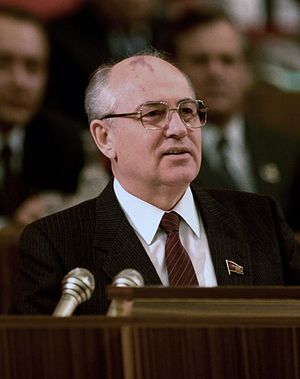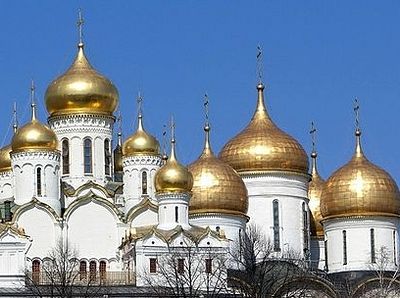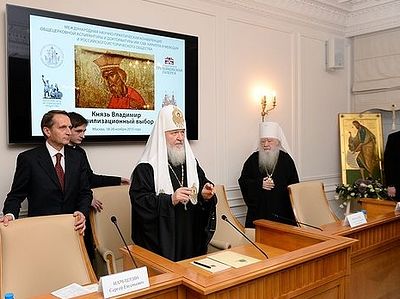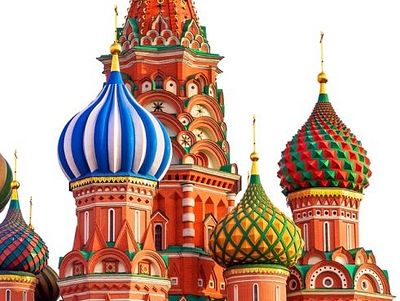The quarter century that has passed since the fall of the USSR has seen the resurgence of the Russian Orthodox Church (Moscow Patriarchate) [1] as a major force in Russian public and political life. Given that the Church is the only ancient public institution which survived Soviet rule, and that it serves to tie Russians to their pre-revolutionary national culture and history, understanding how it came to revitalize and resurrect its cultural influence and political power in the wake of the Soviet collapse is crucial to understanding Russia today. Russian church-state relations beginning with Gorbachev in the mid-1980s were marked by an end to the Soviet policy of marginalization and repression of the MP and growing state toleration of Church influence. The seeds for much of the Church’s rapid rise in political prominence, influence, and power under Yeltsin and especially Putin may be found, ironically, in Gorbachev’s personal attitudes and official changes in state policy toward the Church during his tenure at the helm of a USSR where, ironically, Marxist-Leninism and atheism remained official state ideologies until the 1991 collapse. Patriarch Aleksey II proved crucial to developing, along with Gorbachev and later Yeltsin, many aspects of this new church-state relationship which marked a complete departure from Soviet leaders’ entrenched anti-Church attitudes, laws, and policies before 1985. By the fall of the USSR, the Church’s resurgence and revitalization had already begun, and would only deepen and grow stronger in the following years.
Gorbachev and the Church’s new-found freedom: mid-1980s to 1991
As Metropolitan Hilarion (Alfeyev) observed in a January 2008 lecture one year prior to then-DECR chairman Metropolitan Kirill’s election as Patriarch and Hilarion’s own appointment as Kirill’s replacement, the case for a genuine religious reawakening in Russia can be made from as far back as the period of perestroika and glasnost under Gorbachev in the mid-to-late 1980s when Russia remained an officially atheistic communist republic. [2] As former Reagan adviser and Russian cultural historian Suzanne Massie observed in a lecture she gave at the Washington DC Kennan Institute in December 2008 [3], by the 1980s, an astonishing “55 million Russians were willing to say that they were Orthodox (almost three times as many as were in the Communist party).” [4] That a solid majority of Russians identified themselves as Orthodox in an officially atheistic political society is remarkable and speaks to the tenacity of Orthodox identity as an integral part of historical memory for most Russians. One telling anecdote Massie noted in her lecture, is that when reporters asked Gorbachev in France whether or not he had been baptized, he responded incredulously “Yes, isn’t everybody?” [5] [6]. For the leader of the Soviet Union to utter these words is nothing short of astonishing, and speaks to the Church’s quiet but continued influence among ordinary Russians despite intermittent waves of persecution under the communist regime.
A major watershed moment for the Church came leading up to the 1988 millennial anniversary of the historic baptism of Kievan Rus under Prince Vladimir the Great, in which, ironically, major state-supported religious celebrations took place in Kiev, Moscow, Saint Petersburg, and many other cities. [7] While many anti-Kremlin Ukrainian Catholic and Orthodox leaders and faithful laity opposed and protested the Soviet-sponsored celebrations, successfully urging Pope John Paul II not to attend any of the events in the USSR but to send a delegation in his place [8], major Orthodox dignitaries from around the world did attend. The Ecumenical Patriarch was, however, notably absent.
In the wake of these celebrations in numerous Russian, Ukrainian, and Belarusian churches, and the previously unimaginable state-sponsored publication of commemorative plaques, medals, and history books about the Millennium, the atmosphere of greater openness Gorbachev sought to encourage resulted in something happening which was unthinkable before his tenure: the Soviet state returned many desecrated churches and confiscated ecclesiastical properties to the Church. This began before the anniversary, but culminated with the symbolic handing back of the Kiev-Pechersk Lavra [9], the center of Orthodox spiritual life in Ukraine, to the MP. Despite that many Ukrainian observers disappointedly noted how the commemorative events centered around Moscow, not Kiev [10], even if the celebrations were Russocentric, they were nevertheless enthusiastically observed throughout the USSR. Soon after the Millennium, the Soviet state sent shockwaves throughout Orthodox and Catholic circles by lifting the universal ban on religious broadcasts on state television. As Marilyn Pfeifer Swezey — Massie’s friend and a former Hillwood Museum docent [11] — observed in an interview, this meant that for the first time in Soviet history, both Orthodox believers and non-catechized Russians curious about their patrimonial Church could view Orthodox religious services on state television, the primary source of electronic media. As Ms. Swezey recalled, these services were immensely popular in part because everyone wanted the thrill of participating in history, in something that had until only recently been forbidden.
Ms. Swezey’s friend and spiritual father, whom she aided for over a decade as his personal assistant, was a Russian Orthodox bishop Basil Rodzianko (formerly Fr. Vladimir, 1915-1999) [12]. A veteran BBC religious news broadcaster to the Soviet Union who produced thousands of tape cassettes of Orthodox spiritual talks, sermons, and reflections, in the late 1980s Bishop Basil produced a widely circulated Russian language video “Reemergence” on the ongoing revitalization of the Church in Russian public life. Russians widely regarded Vladyka Vasily as a starets in the Orthodox mystical tradition; as my godmother, his assistant, told me, on one visit to a rural Russian village in the early 1990s, babushki crowded around him exclaiming “He is with the angels!”. Bishop Basil was formed spiritually during his Belgrade youth by Church luminaries living there at the time such as Metropolitan Antony (Khrapovitsky), the first First Hierarch of ROCOR, and the future St John (Maximovitch), archbishop of Shanghai and San Francisco. [13]
Ms. Swezey credits Gorbachev’s reformist political policies with “liberating” the Church from what Bishop Basil and all his episcopal friends in Russia regarded as the “Soviet captivity” under Stalin, Khrushchev, and Brezhnev. She helped Bishop Basil and a Washington DC committee in defense of persecuted Christians organize the first ever state-approved religious pilgrimage to visit historic Russian churches and monasteries for the 1987 Nativity and Theophany celebrations. Ms. Swezey emphasized that this would have been unthinkable before Gorbachev; his predecessors simply never would have allowed it. Bishop Basil’s radio broadcasts had inspired a large popular following in Russia, and many people recognized him during the 1987 pilgrimage from his distinctive voice.
At this time, the timid Patriarch Pimen headed the Church (r. 1971-1990); he had endured house arrest for a number of years and rumored torture, as Bishop Basil recalled, and was unwilling to approach the Soviet authorities about the upcoming 1988 Millennial celebrations for fear of incurring their displeasure. Bishop Basil was aware from his close contacts on the MP Synod that, prior to Gorbachev, neither Brezhnev nor his two elderly, old guard successors had been willing to permit the Church to plan any public commemorations of the Millennial anniversary in major Soviet cities, especially Kiev and Moscow. In contrast to this ideological refusal, Gorbachev’s openness represented a virtual sea change in state attitudes toward the Church as an institution in Soviet public life.
One example of this radical change under Gorbachev, as Ms. Swezey related in the interview, was at a major diplomatic reception in the Kremlin in fall 1986. Bishop Basil’s friends on the Synod informed him that at the reception, at which both Gorbachev and Patriarch Pimen were present, the General Secretary approached the Patriarch, asking him “are you having any difficulties in your preparations for the Millennial celebration?” , knowing full well that he was. The Patriarch, taken aback, responded “no”. The General Secretary replied diplomatically, “Well, if you do have any difficulties, let me know” and the state would step in to help. As a result of this conversation, and the tidal wave it represented of a subtle but definitive change in official state attitude toward the Church, soon after it was announced that the ancient, crumbling Danilov Monastery in Moscow would be fully restored and serve as the principal patriarchal administrative center and site of the Millennial celebrations. By the time of Ms. Swezey and Bishop Basil’s pilgrimage with American Orthodox believers in January 1987, major restoration work on the monastery had already begun. These construction and restoration projects could never have occurred before Gorbachev’s tenure.
Ms. Swezey emphasized that most of this repair work was not financed by state coffers or supervised by the Soviet authorities, but represented a genuine, large-scale, organic outpouring of support and labour from all segments of Russian society. Ordinary babushki, specialist artisans, and thousands of ordinary Russian men and women set about donating what they could and helping physically in the restoration efforts at the Danilov and other monasteries and churches, mirroring the later efforts under Patriarch Aleksey in the 1990s to rebuild Christ the Saviour Cathedral which Stalin had demolished in 1931. [14]
One cannot ignore the personal aspect of Gorbachev’s reasons for so abruptly and completely reversing his predecessors’ restrictive approach to the Church. As Bishop Basil recalled to Ms. Swezey, it was universally known among Orthodox believers that Gorbachev’s mother was an active churchgoer and dedicated parish council member in Stavropol. After becoming General Secretary, Gorbachev ensured that a new parish church was built close to his mother’s residence.
Ms. Swezey described how, in her view,
the whole country came to do the work and donated rubles. The Church seemed to come together as people came to do the reconstruction and restoration projects — not just carpenters and masons and other specialists, but ordinary grandmothers and unskilled male laborers. Somehow the Church collected the money needed for all the construction projects, and this was no easy task, as the Danilov, among so many others like it, was in a state of rubble and near collapse.
Gorbachev not only designated the Danilov as the principal locus of the upcoming Millennial events, but facilitated the construction of a new administrative building from which to oversee the restoration work. Talking with a young monk at the Danilov who spoke excellent English, the American Orthodox pilgrims led by Bishop Basil and Ms. Swezey learned a revolutionary bit of news: the monk said quietly “Well, you see, we believe that the celebration of the Millennium will bring about a new baptism of Rus” and the reemergence of the Church as a prominent force in public life. Ms. Swezey clarified that this meant that Church leaders and ordinary faithful anticipated an organic revival of the Church’s position, but not the fall of communism itself. Like most clergy, Bishop Basil always attributed the rapid fall of the USSR to God’s providence.
Around this time, Bishop Basil learned that Gorbachev had asked four senior MP Synod bishops to meet with him, and that he had proposed an unprecedented, revolutionary alliance which violated the core tenets of Marxist-Leninism’s view of religion generally as an enemy of the working class and Bolshevism’s view of Orthodoxy in particular as backwards, superstitious nonsense. In the wake of Gorbachev’s campaigns to push for a more open and healthy society, Bishop Basil’s episcopal friends told him that the General Secretary asked the Synod bishops to enlist the Church’s cooperation in helping to restore what he called “moral values”, offering the Church a major cultural role in the public life of what he envisioned as a new, revitalized Soviet society. This shift in 1987-88 not only marked the end of all remaining Soviet state attempts to marginalize the Church, but instead prefigured the future efforts of Yeltsin in the 1990s and Putin since the early 2000s to co-opt the Church and use its influence to buttress government policies and ideals.
Under Aleksey II and Yeltsin: Greater transparency, confronting the Soviet legacy, renewed public prominence, and the seeds of close cooperation between Church and State:
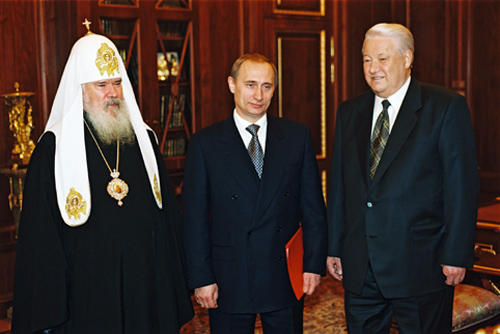 Patriarch Aleksey II, Vladimir Putin and Boris Yeltsin
Patriarch Aleksey II, Vladimir Putin and Boris Yeltsin
Patriarch Pimen’s death in 1990 and the election to choose his successor marked a second major watershed; this was the first free (non-Soviet controlled) patriarchal election since the 1917 All-Russia Sobor raised St Tikhon as the first Patriarch since Peter I let the office fall into abeyance. Whereas Pimen and his predecessor Aleksey I (r. 1945-70) had presided over a Church which was completely dominated by, collaborated with, and subservient to the communist state [15], Aleksey II was the first patriarch to lead the Church in the post-Soviet era. He was chosen in large measure due to his established “reputation as a conciliator, a person who could find common ground with various groups in the episcopate.” [16] As Metropolitan Hilarion (Alfeyev) observed in a December 2013 interview with Pravmir, prior to his elevation as Patriarch, then-Metropolitan Aleksey served as a member of the Supreme Soviet, the highest parliamentary body, and he was thus well acquainted with all senior Soviet leaders at the time of his election. [17] As one of the archbishops who voted for his election observed in the MP’s official journal in October 1990, “With his peaceful and tolerant disposition Patriarch Aleksi will be able to unite us all.” [18] Aleksey was thus expected to be a conciliator and peace-builder who would work to resolve the tensions in Soviet (and soon, post-Soviet) society without upsetting the communist old guard who had reluctantly agreed not to interfere in the election process.
Unlike his two Russian predecessors whom Stalinist repression had cowed, Aleksey was born in Tallinn to an ethnically Baltic German family of emigres who had fled the 1917 Revolution. He grew up in a religious family prior to the Soviet invasion of his country, and thus, he was raised in a society in which the Church was essentially free. During his first year in office, as Soviet institutions remained paralyzed, the economy struggled, and millions of citizens suffered the fear and uncertainty of not knowing what the year would hold politically and economically, Aleksey shrewdly capitalized on the Soviet state’s weakness to insist on an increasingly public place for the Church in society. [19] Whereas Pimen had been shocked and unprepared for Gorbachev’s openness and desire to work with the Church, Aleksey quickly became a vocal advocate of what he regarded as the Church’s rights, calling for the Soviet government to allow religious education in state schools [20] and for a “freedom of conscience” law to protect believers from discrimination. [21] During the attempted communist hardliner coup in August 1991, the Patriarch shocked the Soviet old guard by publicly denouncing the plotters’ arrest of Gorbachev. [22] He went further and declared the plotters excommunicated (a largely symbolic gesture, since they were all atheists, this kind of bold gesture of defying the communists would have been unimaginable five years earlier). In a series of press releases and public statements, the Patriarch denounced the communist junta as illegitimate, implored the military not to attack the legitimate elected authorities, and demanded that Gorbachev be allowed to address the Soviet people. [23]
In order to better understand how the Church came to dominate Russian public and political life as it does today, it is crucial to first realize that the Orthodox religious revitalization began under Gorbachev, who, ironically, played a leading role in reviving this ancient anti-communist institution which would ultimately outlast the Soviet state he sought to restore. While Gorbachev departed from power in 1991 following the dissolution of the USSR, Patriarch Aleksey remained as the earthly head of the Church until his death seventeen years later.
As patriarch in post-Soviet Russia after 1991, Aleksey presided over Orthodoxy’s historic revitalization and re-emergence in Russian public life. It is a telling sign of his tenacity that Aleksey managed to outlast Yeltsin’s time in office, attend and formally bless the new President Putin’s first inauguration in May 2000, and, upon his death in December 2008 and his almost-official state-level funeral, receive official words of praise and elegies from both Putin and Medvedev.
Ms. Swezey recounted from her many visits to Russia how the Patriarch managed to retain a degree of popularity as his Church grew in appeal and public stature while old Soviet institutions crumbled, the Russian economy floundered under hyperinflation, and public confidence in democratically elected President Yeltsin quickly evaporated. As the economy worsened, the churches filled, becoming, as she recalls, stiflingly crowded on major holidays. Unlike his predecessors who never dared to publicly criticize the Soviet regime, during Aleksey’s first official visit to Germany in 1995, the Patriarch publicly apologized for the “Communist tyranny that had been imposed upon the German nation by the USSR”, for which Russian Communists criticized him for his supposed insult to Russian national memory. [24]
Symbolic of the Church’s ever-increasing role in public life, Patriarch Aleksey presided over the combined country-wide and international effort to rebuild the historic Christ the Saviour Cathedral in central Moscow, which Alexander I had ordered erected as a monument to Russia’s overcoming Napoleon’s Grand Army in 1812. Donations poured in from across Russia and the Orthodox world, and momentum continued to build for the temple’s dedication as a monument to all victims of Soviet oppression.
Ms. Swezey observed how it was universally known among all Russians that every Orthodox cleric, every seminarian seeking an ecclesiastical career in the USSR had to have a modus vivendi with the KGB; they were vetted by KGB officials and received frequent visits from their designated KGB handlers. Every Russian patriarch from Sergey on was rumored to have been a secret KGB agent, which the MP strenuously denies to this day. In an unprecedented gesture of transparency and reconciliation, Patriarch Aleksey boldly discussed the issue of collaboration between MP clergy and the Soviet state in a wide-ranging interview with Izvestia in June 1991, imploring forgiveness for the role Soviet-era hierarchs had in agreeing to the Soviet domination of the Church:
Before those people, however, to whom the compromises, silence, forced passivity or expressions of loyalty permitted by the leaders of the church in those years caused pain, before these people, and not only before God, I ask forgiveness, understanding and prayers. [25]
Serge Schmemann, award-winning son of the late Orthodox theologian Fr. Alexander Schmemann [26] and former Associated Press and New York Times Moscow Bureau chief, noted in November 1991 in The Times the many challenges facing Aleksey in the post-Soviet era:
Standing at the center of the magnificent Cathedral of St. Isaac [St Petersburg]… diamonds and rubies glittering from his miter and staff and with a host of Romanov princes, politicians and worshipers arrayed around him, Patriarch Aleksy II… was the image of the church victorious over seven decades of militant atheism.
Not long ago the great domed cathedral was a state museum, the Romanovs were a curse, no Soviet politician would dare step foot in a working church and Patriarch Aleksy was a bishop locked in a running struggle with atheist watchdogs of the State Council of Religious Affairs.
[F]or all the obvious gains of the Russian Orthodox Church and of religious freedoms in the years of perestroika, the 62-year-old Patriarch, like his country and his church, is also a leader who faces a barrage of new problems raised by the sudden outbreak of freedom.
In his sermon in St. Isaac Cathedral, the Patriarch… spoke of the urgent need for tolerance and unity. Those are themes to which the Patriarch returns often, as he did in a recent interview in Moscow.
[H]e seemed in personal awe as he checked off the statistics of the Russian church’s rapid revival. More than 5,000 parishes opened since 1988, 106 in Moscow alone. Baptisms tripled, marriages increased ninefold, the number of monasteries up from 18 to 121.
And yet the Patriarch also spoke, as he has in many sermons and speeches, of the deep and profound damage left by Communism.
“The greatest wound inflicted by the Communist dictatorship was lack of spirituality,” he said. “All other evils were the result of the planned, systematic and total eradication from the souls and consciousness of the people of the very notion of ‘spirituality.’ I am not even talking about the disgusting anti-church propaganda and actions against the church.” “I never thought the moment would come,” acknowledged the Patriarch,..
“We have to rebuild everything — charity, catechism,” he said. “The new generation has forgotten everything — the very word charity was barred from dictionaries. An immediate revival is impossible, but the will is there.” [27]
Symbolic of Russian society seeking to reexamine its immediate pre-Soviet past and freeing itself from Soviet communist propaganda, Aleksey II presided over the glorification of hundreds of Russian “New Martyrs” — bishops, priests, monks, nuns, and laity killed by the communist regime– including Grand Duchess and Abbess Elizabeth Romanova, widowed sister to the last empress, in 1992, and in 2000 the glorification of the “Royal New Martyrs”, the last Imperial Family, as “passion-bearers” (the assassinated Emperor Nicholas II, Empress Alexandra Feodorovna, Tsarevich Aleksey, the Grand Duchesses, et cetera).
In September 1997, another major watershed moment in Russian church-state political relations took place when the widely unpopular President Yeltsin signed into law, despite vocal American opposition, a parliamentary bill “that protects the Russian Orthodox Church from competition with other Christian faiths…”. [28] While not officially establishing Orthodoxy as the state religion (forbidden by the Russian Constitution), “the law create[d] a hierarchy of religious groups, with the Russian Orthodox Church firmly ensconced in the first and most privileged category while rival Christian groups are afforded a secondary status.” [29]
Patriarch Aleksey unsurprisingly praised the law which cemented his Church’s predominant legal and political position, saying ”Today’s law is another step toward perfecting the legislation that secures and defends the rights of Russia’s believers”. [30] Despite that U.S. Vice President Al Gore had urged senior Russian politicians to persuade Yeltsin to veto the bill, and that President Clinton had personally urged Yeltsin not to sign it, the Church lobbied successfully to pass the legislation, which restricted the legal rights of faiths (mainly Protestants, Mormons, and Jehovah’s Witnesses) that did not have a long-established presence in Russia to organize, proselytize, and build houses of worship. [31]
For those who would espouse the Western liberal critical view and blame President Putin and Patriarch Kirill for (by Western standards) an inappropriate church-state relationship today, this law is vital to understanding that as early as 1997 the Church was essentially operating as a quasi-established state religion, a protected and state-supported institution, and that it was President Yeltsin, the Western-friendly ‘democrat’, and Patriarch Aleksey II, not Putin and Kirill, who presided over this new arrangement. It is astonishing that, in only a decade, the Church went from being a cowed, barely public institution in an officially atheist state under a timid Pimen (a man who had no idea how to influence Gorbachev) to being protected under Aleksey as a semi-established state religion.
The Church in Putin’s Russia: Developing into the unofficial State Church, 2000 to today
Putin’s first inauguration ceremony in May 2000 solidified in a symbolic way the Church’s increasingly dominant role as the preeminent religious institution in Russian society. The Patriarch was not only prominently present at the inauguration in a seat of honor, but he formally blessed the new Russian president with the sign of the cross in the name of the Trinity, and presented Putin with an icon of St Alexander Nevsky.
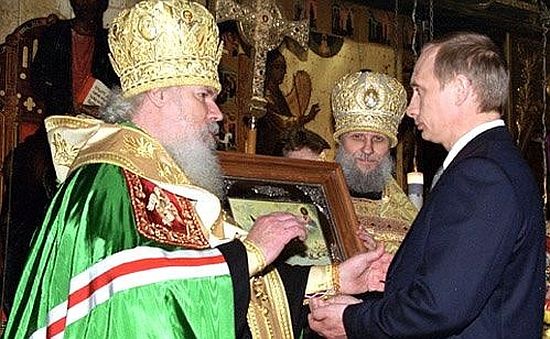 Inside the Dormition Cathedral (Uspenskiy Sobor) in the Kremlin, the Patriarch presents new Russian president Vladimir Putin with an icon of St. Alexander Nevsky at the latter’s presidential inauguration, 7 May 2000.
Inside the Dormition Cathedral (Uspenskiy Sobor) in the Kremlin, the Patriarch presents new Russian president Vladimir Putin with an icon of St. Alexander Nevsky at the latter’s presidential inauguration, 7 May 2000.
As this photograph shows, Putin began his first term as president with the Church’s full symbolic (and literal) blessing. How did church-state relations develop in Russia to the point that in 2015, to all intents and purposes, the Church has become the unquestionably leading religious institution in Russia, whose Paschal and Nativity services the President and Prime Minister publicly attend each year at Moscow’s Christ the Saviour Cathedral? [32] One of the watershed moments was the 19 May 2007 signing of the Act of Canonical Communion between the MP under Patriarch Aleksey and the Russian Orthodox Church Abroad (ROCOR) under Metropolitan Laurus at the Cathedral in the presence of then-President Putin and then-Prime Minister Medvedev. [33] All Orthodox bishops I have talked with about the Act reported that the President had taken a keen interest in the restoration of communion (all these hierarchs likewise hold the President in high regard, including ROCOR’s present First Hierarch, Metropolitan Hilarion Kapral, and the OCA’s [34] former reigning Metropolitan Jonah Paffhausen, now a retired ROCOR bishop). It is impossible to know for certain whether Putin’s behind-the-scenes involvement in the reconciliatory Act is an example of his calculating politically to use the rupture between the Russian Church in and outside of Russia to solidify his political appeal among Orthodox around the world and Russian Orthodox in particular living abroad, or the genuine desire of a devout Orthodox believer who happens to be the Russian president to help facilitate the historic reconciliation. It is entirely possible that both political calculation and genuine piety informed Putin’s role in supporting the Act.
The extent to which, by 2008, Church and state had become firmly intermeshed and intertwined is evident with the Kremlin’s reaction to Patriarch Aleksey II’s death in December of that year. Immediately following his death, President Medvedev — widely held to be more personally devout than Putin — issued a presidential ukaz which “enjoined” that on the day of the Patriarch’s burial Russian cultural organizations and news broadcasters should cancel entertaining programs. [35] This decree stopped just short of ordering a day of full, official national mourning. While the President issued his decree, the Prime Minister (Putin) released a statement via Interfax, an official state news source, lauding Aleksey as a “a prominent figure in the history of the Russian Orthodox Church, as well as a great statesman” who “made a very considerable contribution to relations between various faiths.” [36] Putin also acknowledged that Aleksey “did a great deal to help establish a new governance system in Russia”. [37] Along with their wives, both Medvedev and Putin attended the funeral liturgy in Christ the Saviour Cathedral presided over by the Orthodox primus inter pares Ecumenical Patriarch Bartholomew. [38] [39]
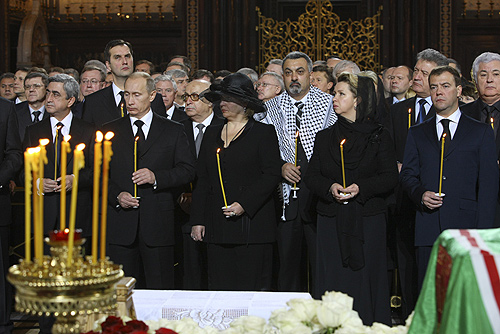 From left: Russian President Vladimir Putin, his then-wife Ludmila Putina, Svetlana Medvedeva, and Prime Minister Dmitry Medvedev at Aleksey II’s funeral liturgy in Christ the Saviour Cathedral, Moscow.
From left: Russian President Vladimir Putin, his then-wife Ludmila Putina, Svetlana Medvedeva, and Prime Minister Dmitry Medvedev at Aleksey II’s funeral liturgy in Christ the Saviour Cathedral, Moscow.
